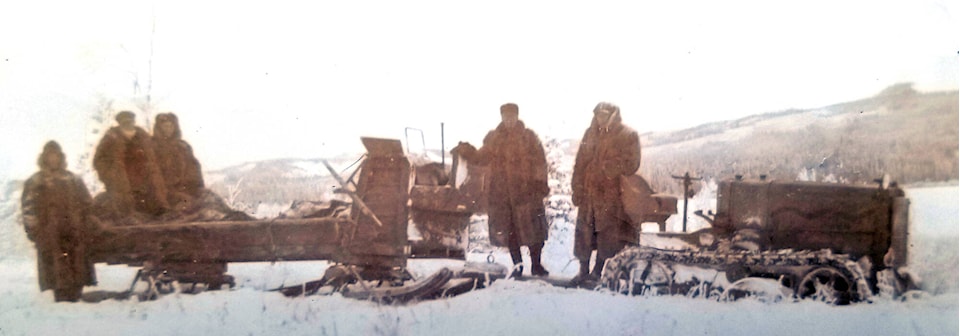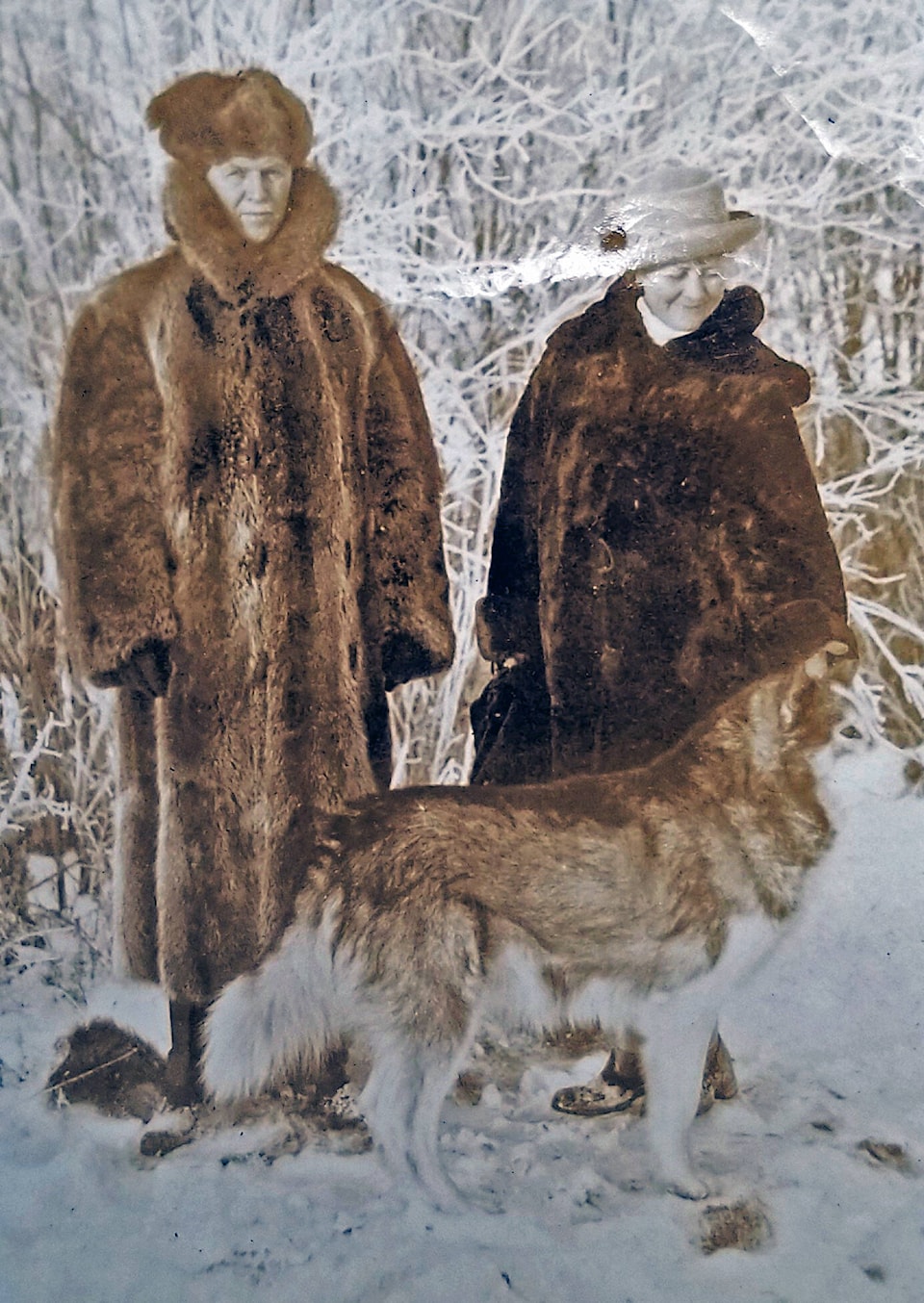Michael Gates
History Hunter
Yukoners take a road trip from Whitehorse to Dawson (or vice versa) for granted these days. When I first moved to Dawson many years ago, the road was unpaved, with many potholes, dusty when it was dry, slick when it was wet. And watch out for the flying gravel! I went through many windshields over the years.
Back then, a trip from Dawson to Whitehorse would take about eight hours, provided I didn’t have to change more than one flat tire (I always carried two spares).
Can you imagine a time when a road trip from Dawson City took eight days? You couldn’t call it a road; it was known as “the overland trail.” It was not extensively developed because river transportation was used heavily during the summers. Only when winter snows covered the overland trail was it suitable for cross-country travel.
To illustrate that journey, let’s accompany George and Martha Black on a trip on the overland trail in 1925. Mr. Black was the Member of Parliament for the Yukon, and he and Mrs. Black would have to travel from his home in Dawson to the nation’s capital when Parliament was called into session. The Blacks were not your average travellers, but their experience was the same as everybody else’s when leaving Dawson City in the winter.
On Nov. 13, 1925, George Black received a telegram from then-Prime Minister Arthur Meighan. Back then, there was no telephone link connecting Dawson City (which was then the territorial capital) to anywhere else. There was no TV, and no internet; the telegraph was the only link, and had only just been upgraded to a radiotelegraph system in 1923.
The message read: “Ottawa, Nov. 13. … Vitally important you be in Ottawa by tenth December. Arthur Meighan.”
Mr. Black wired the CPR agent in Skagway regarding sailing times and was told that the next sailing date would be Nov. 22, followed by another Dec. 2. Angus McIntyre, manager of the stage and mail service, promised “a record trip” to Whitehorse, so that they could connect with the steamer in Skagway on the 22nd.
The Blacks left by automobile the evening of the 14th in the hope of overtaking the horse-drawn mail stage that had left earlier that day.
Passengers rode in these stages in the open air; there was no cover from the cold winter conditions. They reached the first roadhouse at about 3 a.m. By 7 a.m. the following morning, the horses were hitched and ready to leave in the dark.
The next evening, they stopped at Gauvin’s roadhouse, which was a log building, consisting of one large room. One corner was partitioned off in case of female guests and this tiny space held a double bed, immaculately white sheets and pillow covers with wooly Hudson’s Bay blankets.
The meal was typical of the fare enjoyed by passengers at every roadhouse along the way: “A tender and delicious moose roast, preceded by a delectable barley soup; ducks stuffed and baked as only a Frenchman can bake; potatoes raised in the garden; native cranberry jelly, celery and lettuce salad, tender and crisp as though just gathered. Amber coloured coffee with biscuits and cheese to finish.” As Mrs. Black later wrote, their daily fare at each roadhouse consisted of “mountain sheep, moose, caribou, grouse, ptarmigan and delicious fresh fish.”
At Stewart River Crossing, the following day, the ice was not safe for the stage, so they walked across, the ice giving an occasional alarming crack. The last thirty feet or so was covered on duck boards, as the ice was very thin. The horses were led across singly and the mail, personal luggage and some express was brought across on hand sleds.
The roadhouse at Stewart was quite a palatial building—two storeys, built of logs, clean and neat as a pin, with another appetizing meal waiting for them.
Each day, they passed through “groves and forests of spruce, jack pine, willow and poplar. They crossed log bridges over gurgling brooks not yet frozen over and saw tracks of marten and mink leading to the water; lakes with beaver dams; muskrats peeping at them with curious eyes from their winter homes; bands of caribou, unafraid, nosing aside the snow and browsing on the moss beneath and once, just a glimpse of a cow moose and a fully grown calf.”
The rivers were late in closing in 1925. The Pelly River was still open when they reached it and as the river was still free of ice, they crossed the Pelly without incident. They watched the sunset at 3 p.m.
From Pelly to Yukon Crossing, they rode in an open sleigh towed behind a caterpillar tractor. The cat lurched and crawled across the landscape, day and night, for forty-eight hours, through “forest and swamp with endless vistas of snow-covered trees.” They reached Yukon Crossing at about 2 a.m. In the darkness, the water looked like a river of ink running thick with ice.
The two drivers, and other passengers, gathered up the tow line and the boatmen kept the canoe out from the jagged shore with a pole. The canoe was towed up river for about a third of a mile as they would otherwise have been carried by the current downstream past their destination on the opposite shore.
Finally, the boatmen and passengers got in and paddled across the river with only the light from a lantern in front of the roadhouse on the opposite shore to guide them. The ice grated sullenly against the sides of the canoe; however, they landed safely directly in front of the roadhouse and found another good hot meal waiting.
After an hour’s rest, they travelled in a pair of Ford automobiles. In case one broke down, they could continue in the other. The Fords “slithered through drifts, crossed rickety bridges, climbed hills like a mountain goat, fairly leaped from crag to crag.”
The last river crossing to be made was at the Takhini River. Here, the ice had formed but was not strong enough to permit the Ford to cross. A line was stretched from shore to shore; a lane was chopped wide enough to allow the passage of a row boat and the passengers and boat made a safe crossing.
The Takhini crossed, they again boarded a Ford, this time a four-passenger model, and completed the final 30 miles into Whitehorse, which they reached around 3 a.m. on Sunday, Nov. 22.
As the steamer Admiral Rogers had been delayed by storms, as was often the case, the Blacks remained in Whitehorse until Monday morning when the special train for the coast pulled out. On the Pass, they encountered heavy snow drifts and a slide that had to be shovelled through. On Nov. 23, they boarded the steamer at Skagway, where “rain and fog took the place of sunshine and frost,” and continued their long journey to Ottawa.
There is a lesson to be learned from this: that travel was not always as easy as what we enjoy today. We take this convenience for granted. Given the kind of isolation that Dawson City experienced in the early days of the 20th Century, it can be easily understood why many Dawsonites still refer to points beyond the Yukon borders as “Outside.”
Michael Gates was the Yukon’s first Story Laureate from 2020 to 2023. His latest book, “Hollywood in the Klondike,” is now available in Whitehorse stores. You can contact him at msgates@northwestel.net

